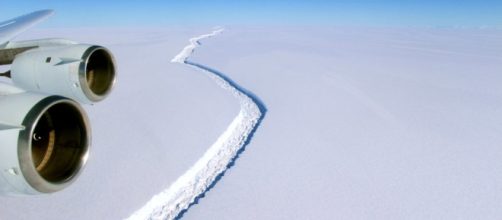A large portion of an Ice Shelf in Antarctica is about to disintegrate into the surrounding sea, leaving environmentalists worried about the implication of the incident. When the portion breaks off, it will likely create the largest iceberg ever recorded in human history. Scientists predicted that the rift in the ice shelf would form an iceberg 1,930 square miles in size, which is equal to the size of the state of Delaware.
The rift getting bigger
Within the last six days, the rift increased in size very rapidly and in that time covered around 10.5 miles.
It is now just 8 miles off the coastal edge. Till now, the rift progressed parallel to the coast but almost a week ago, the rift drastically changed direction and is now heading straight toward the sea.
Researchers said that this sudden change in direction indicated that the portion of the Larsen C Ice Shelf would soon break off and drift out to sea. The Larsen C shelf will lose around 10 percent of its total area when the portion disengages. Not only would it raise concerns about global sea level rise but, the Antarctic Peninsula will also be transformed forever.
Some scientists have even claimed that there is a high chance that the whole Larsen C will disintegrate alongside the rifted portion.
This process will not take very long to occur and may take place within a couple of days at most.
Repercussions of such disintegrations
Researchers claimed that such an event can lead to rise in global sea levels. This is brought on due to the fact that these ice shelves prevent glacier waters from reaching the sea. However, without the protection of the Larsen C, huge amounts of runoff will be deposited into the sea, which in turn will increase sea levels.
A similar ice shelf had disintegrated back in 2002, named the Larsen B. At that point of time, the shelf had gone through the similar behavior as the Larsen C is currently undergoing. The phenomena of the rifting and breaking off are a natural process, which scientists feel have been aided by the climate change. With the warming up of the ice, water stays back on the ice surface, causing the structure to weaken.
The ocean temperatures have also risen in the past few years, further causing problems. For instance, the ice shelves are getting thinner due to the warmer water, which prevents the formation of thicker ice. These reasons also indicate that once the iceberg separates from the shelf, it is highly unlikely to come back.


